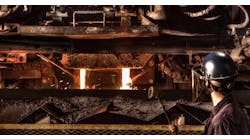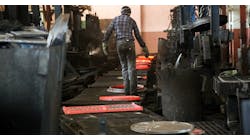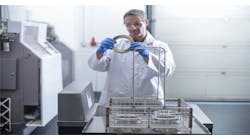Recent decades have been marked by global growth in manufacturing and a growing acknowledgement of the human impact on the environment. The proponents of that point add that changes in climate conditions – and adverse conditions that many experts attribute to such changes – now require radical changes in how manufactured goods are produced and consumed. Because manufacturing is a major contributor to climate change, they argue, and manufacturers must implement changes to make their operations “sustainable.”
Sustainable manufacturing. The National Council for Advanced Manufacturing USA (NACFAM) defines sustainable manufacturing as creating products using non-polluting processes that also conserve energy and natural resources. Sustainability focuses on what is good for consumers, employees, and ultimately for the environment. It satisfies changing consumer preferences, and it’s the right step to preserve the environment.
Environmentally responsible manufacturing also improves business value. According to McKinsey research, embracing sustainable measures in manufacturing builds value by:
• Top-line (revenue) growth;
• Cost reduction;
• Reduced regulatory and legal interventions;
• Improved employee productivity; and,
• Higher investment and asset optimization.
Here are five ways to adopt sustainable practices in the manufacturing process.
1. Maintenance for optimization. Equipment and facilities are overlooked in discussions of manufacturing sustainability. Machine breakdowns have repercussions across the value chain and the environment. Machines that are not maintained adequately consume more energy and resources, resulting in inefficient manufacturing processes.
Regular maintenance improves machine life, resulting in reduced scrap and less consumption of resources that go into manufacturing equipment. Maintenance of transportation vehicles reduces fuel consumption and increases their lifespan. Similar advantages apply to well-maintained buildings and infrastructure.
Manufacturers can rely on a cloud-based computerized maintenance management system (CMMS) to gain a complete view of maintenance in their facilities. CMMS also helps to meet sustainability goals with maintenance scheduling, maintenance automation, and predictive maintenance tools.
2. Carbon capture. Carbon capture processes and safely stores carbon dioxide (CO2) produced during manufacturing processes. When greenhouse gases are not emitted into the atmosphere, the impact of manufacturing processes on the environment is limited.
Manufacturers should implement carbon capture in production facilities to limit greenhouse gas emissions. Implementing the technology requires a huge upfront cost, but the benefits outweigh the cost for large manufacturers over a larger time frame.
Manufacturers that have made efforts to reduce greenhouse gas emissions with carbon capture have given rise to a market for carbon offsetting. This involves purchasing carbon credits from brokers or 'green' businesses, which are then marketed as making the company 'carbon neutral' or 'carbon negative.' However, in reality, these actions may do very little to reduce carbon emissions.
While some industries cannot avoid carbon emissions, investing in ‘green’ projects by buying carbon credits will support sustainability.
3. Improving resource utilization. Responsible consumption of energy and natural resources is another facet of sustainable manufacturing. Manufacturers need to identify the avenues where resources are being wasted. The use of unreliable machines that are not maintained periodically consumes more energy for operations. Similarly, manufacturers can minimize the waste of raw materials in manufacturing processes.
Efficient transportation — using fuel-efficient vehicles and route optimization — is another way to improve resource utilization in delivering a product to consumers. Such efforts not only improve the sustainability of manufacturing, but also reduce the cost of operations, improving profitability.
4. Green audits. Green auditing is the process of identifying the environmental impact of the manufacturing processes. Green audits investigate, understand, and identify the efforts manufacturers have taken to address environmental challenges. Green audits performed by independent entities are beneficial for manufacturers and consumers alike.
Openly published audits give consumers insights into the sustainable processes involved in the products they are about to purchase. Consumers can alter their purchase decisions based on these reports, and manufacturers can use green audits to identify ways they might improve the sustainability of their operations and increase process efficiency.
5. Sustainable alternatives. Energy and raw materials are critical in manufacturing processes. Manufacturers should adopt viable alternatives for them to minimize the impact on the environment. Production facilities need to try to source renewable energy.
Steps toward that goal might range from installing solar power arrays at manufacturing sites to researching the sources of energy to power the plant. Any effort in this direction has to begin at the planning stage for manufacturing facilities. For example, if the project area has a natural geyser, the facility has to be designed to use the natural geyser for heating and energy. Similar implementations can be beneficial in the attempt to achieve sustainability.
Manufacturers should explore the use of less-polluting raw materials too. Even selecting the same material sources from different suppliers can alter a plant’s carbon footprint. Manufacturers should investigate how raw materials are sourced to find better alternatives for their processes.
Sustainability for profits. Sustainability has become a significant consumer consideration while making purchase decisions. Manufacturers have caught on to that, and taken measures to position themselves as green business.
Real progress toward sustainability will happen when a manufacturer realizes that long-term profit and business value are possible due to sustainable practices. At the same time, they must be wary of the greenwashing that is rampantly growing in the manufacturing space. They should research the products they purchase and not just rely on communication from the producers. Sustainability efforts that chase business profits rather than moral standing are much more sustainable.
Bryan Christiansen is the founder and CEO of Limble CMMS, a mobile CMMS software that helps plant managers organize, automate, and streamline maintenance operations.









